Ecommerce Trend Report: The State of the Industry in 2022
Ever since its early days, ecommerce has always been among the fastest-growing industries. And during the past two years, ecommerce has gone through its biggest transformation yet, but it’s far from being over. Here is what has happened in the world of ecommerce over the year and where it’s expected to go in 2022.

Ever since its early days, ecommerce has always been among the fastest-growing industries. And during the past two years, ecommerce has gone through its biggest transformation yet, but it’s far from being over. Here is what has happened in the world of ecommerce over the year and where it’s expected to go in 2022.
The Post-Pandemic State of Ecommerce
While we are not yet at a point where the world can be declared post-pandemic, and the effects of Covid-19 are still noticeable, the ecommerce industry has changed dramatically over the last two years. These are the most notable trends of post-Covid ecommerce.
The Inevitable Slowdown of Growth in 2021
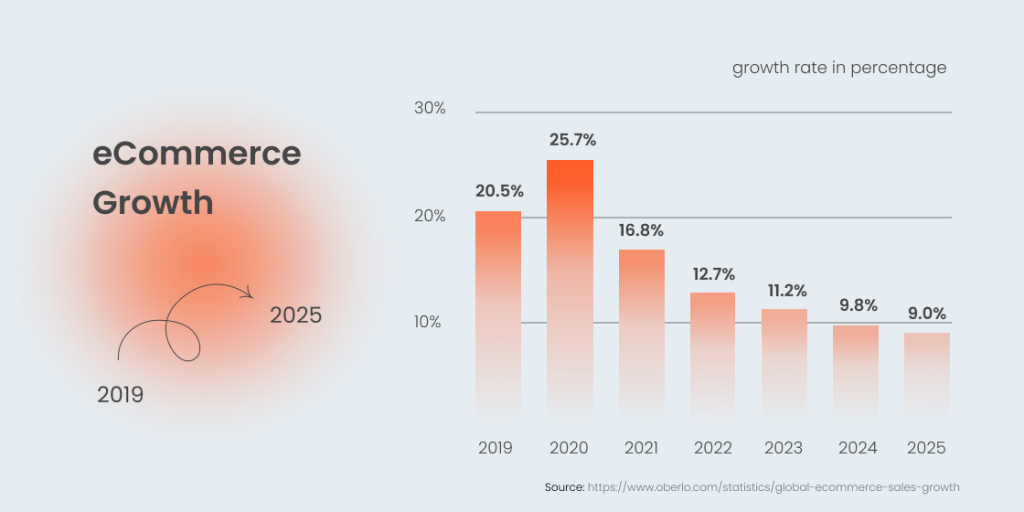
After ecommerce sales skyrocketed in 2020, the slowed-down growth was to be expected in 2021. Compared to 2020, when the ecommerce sales increased by 25.7%, 2021, with its 16.8% growth rate may not have looked as impressive.
However, the slower growth can be explained by several factors, from the return of buyers to in-store shopping to the issues with the supply chain, which limited the sales possibilities for many ecommerce businesses.
Online Window Shopping is an Emerging Trend
Since the beginning of the pandemic, ecommerce has witnessed the emergence of a new trend: online window shopping. In order words, potential buyers are increasingly often filling their shopping carts and then abandoning them before checking out.
This definitely started out as a pandemic trend, when the inability of the buyers to visit physical stores, paired with them being stuck at home during lockdown, forced them to look for substitutions to their usual shopping habits.
At the beginning of the pandemic, up to 94.4% of shopping carts were abandoned. On average, up to 70% of carts are abandoned across all ecommerce markets with the highest abandonment rate belonging to mcommerce, where 85.65% of users fill their shopping carts and never return to them. This amounts to $18 billion in lost revenue every year.
The possible solutions for this problem are redesigning your shopping cart, adding clear calls to action, and offering guest checkout. This alone can increase your conversion rate by 45%.
Buyers Won’t Tolerate Covid-Related Service Disruptions
The ecommerce industry has faced many challenges since March of 2020, including product shortages and shipping delays. However, for a majority of buyers, all that matters is the last-mile point of service. A buyer still expects to get the necessary product at an adequate price and within a reasonable time frame.
Only 1 in 5 US consumers are willing to forgive service providers for delays and other service inconsistencies, but there are exceptions to this trend — brand loyalty makes the buyers more lenient even in the case of order complications.
Customers are More Conscious of Their Brand Support
The post-pandemic ecommerce landscape has seen a shift in customer loyalty and priorities. When a customer finds a brand that matches their expectations and ethics, they are highly likely to stick around with it even through shipping delays and product stockouts.
Moreover, customers are now less likely to randomly choose a brand to support. For example, for 47% of the buyers, it’s important for an ecommerce store to have a local presence, while 78% of the buyers have admitted to shopping more with nearby establishments to support the local economy.
And price is a less significant factor in the selection process for many buyers, as 7 in 10 buyers would rather support a local business even if it means paying more.
The Increase in Out-of-Home Activities
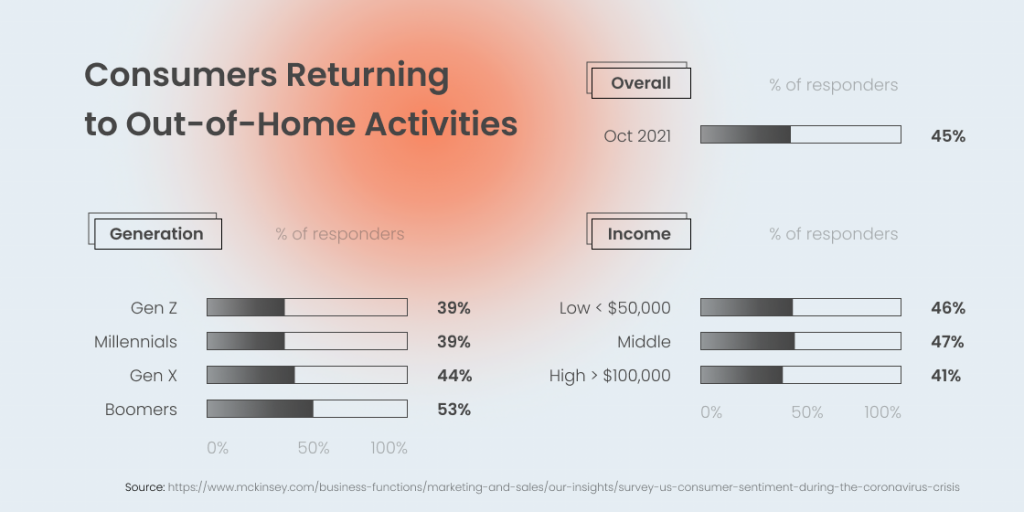
Compared to 2020, 2021 saw the return of consumers to out-of-home activities. By October 2021, around 50% of US consumers were starting to leave the house more — not just for shopping, but also for working from the office, enjoying social events, and eating out indoors. There has been a 44% increase in these activities from January of 2021.
The out-of-home return rate depends on several factors, including generation, with baby boomers being 14% more likely to leave home than Gen Z, and high-income households staying at home more than low and middle-income families.
Products with the Most Rapid Growth in Sales
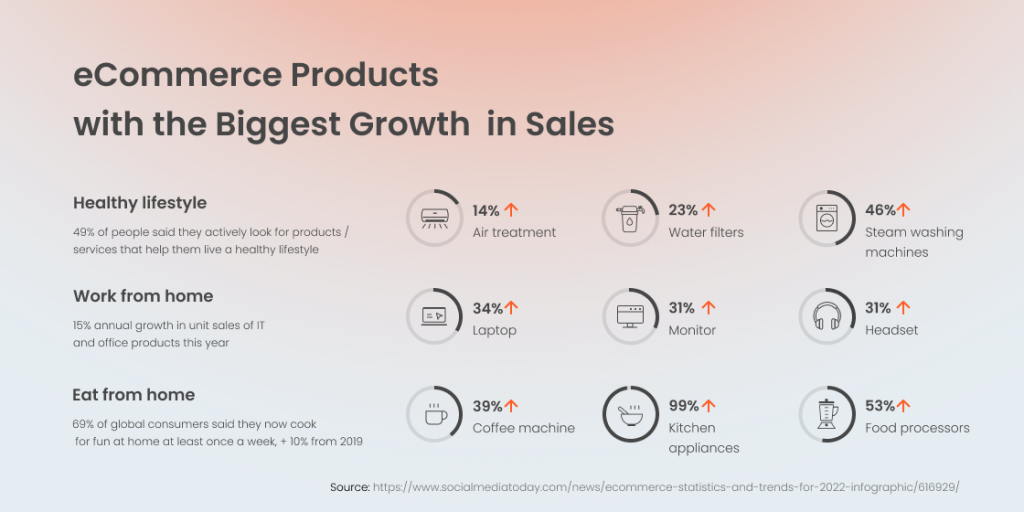
Over the course of the pandemic, different products have gone through waves of popularity. However, some products have enjoyed a steady demand and have performed well in sales throughout these two years. Most of the highest selling products can be categorized into three groups:
- Healthy living: air purifiers, water filters, steam washing machines;
- Working from home: laptops, monitors, headphones;
- Cooking: kitchen appliances, food processors, coffee machines.
After the astronomic growth of 2020, ecommerce is now adjusting to the new reality. With customer priorities shifting and them being more conscious of their brand loyalty, ecommerce businesses need to strengthen their positions on the market, as consumers will be quick to move on to the competitors if they are not satisfied with the service they are getting.
5 Ecommerce Trends to Watch Out For
As one of the most rapidly growing industries, ecommerce regularly undergoes minor and major transformations, and the 2021/2022 season is no exception. There are several notable trends that give a pretty good idea of where the industry is at right now and where it’s going, and here are some of them.
The Supply Chain Crisis Threatens the Whole Retail Industry
In 2020, shipping delays and product stockouts affected not just the world of ecommerce, but also the retail industry as a whole. This was a particularly big problem during the 2020 holiday season, when millions of buyers received their orders weeks after the winter holidays, which led to a massive string of returns of gifts that were no longer needed.
And that is never good news for a small or medium ecommerce business.
Things have only gotten more serious since then. In 2021, ecommerce companies have experienced a shortage of not only the products they are selling, but also the packaging materials and replacement parts for the warehouse equipment.
There are several reasons for the current supply chain crisis, from the shipping container shortages and an over 500% increase in shipping costs from China to the container congestion in major ports. What matters the most is the ability of ecommerce businesses to quickly adapt to new conditions.
Among other things, ecommerce companies should consider diversifying their supplier base to avoid further complications and using tech solutions to make data-driven decisions. For example, data analytics tools can help you predict customer demand, thus helping you understand which products to stock on.
Omnichannel Ecommerce is on the Rise
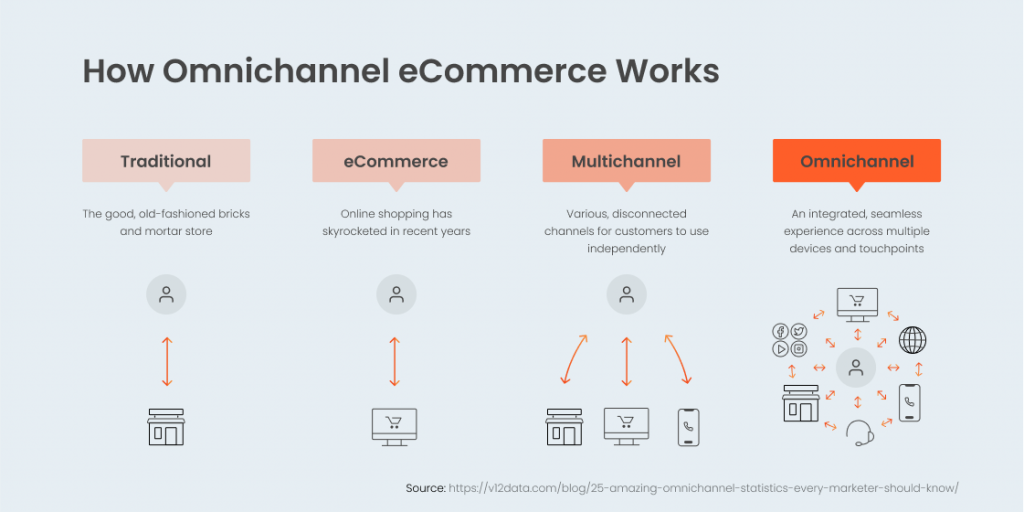
The omnichannel retail strategy — the practice of creating a seamless shopping experience for the buyer across all available channels, including ecommerce and brick & mortar stores — is not exactly a new trend. But since 2020, it has shown significant growth. With omnichannel campaigns delivering a 287% purchase rate, omnichannel marketing efforts are definitely paying off.
According to Think With Google, while the number of people shopping online has increased significantly over the past two years, 66% of buyers still plan to shop in-store. Moreover, a buyer 15 years ago typically went through two touch-points to buy a product, while a modern buyer goes through six on average.
It means that your campaigns cannot be one-sided and need to involve different kinds of media, from social media and email marketing to handing out flyers.
Social Ecommerce Unlocks New Possibilities
For years, ecommerce businesses have been active on social media. However, companies mostly used social media websites to allow more potential customers to discover their products, not to sell to them directly. And those efforts were not fruitless, as 70% of buyers are now taking to Instagram to plan their next purchase.
Of course, Instagram is not the only platform to host your social commerce campaigns. Facebook and Pinterest have already rolled out shopping functionality, and YouTube, TikTok, and Twitter are testing different versions of “shop now” buttons.

Top 10 Ecommerce Categories of 2021/2022
If you are only starting an ecommerce business or want to make your existing one stronger with the addition of new categories, looking at the most popular categories can be helpful in a number of ways. These are the 10 ecommerce categories in the US that performed the best in 2021.
- Computer and consumer electronics.
- Apparel and accessories.
- Furniture and home furnishings.
- Health, personal care, and beauty.
- Toys and hobbies.
- Auto and parts.
- Books, music, and video.
- Food and beverage.
- Office equipment and supplies.
- Other.
The Growth of Ecommerce Platforms
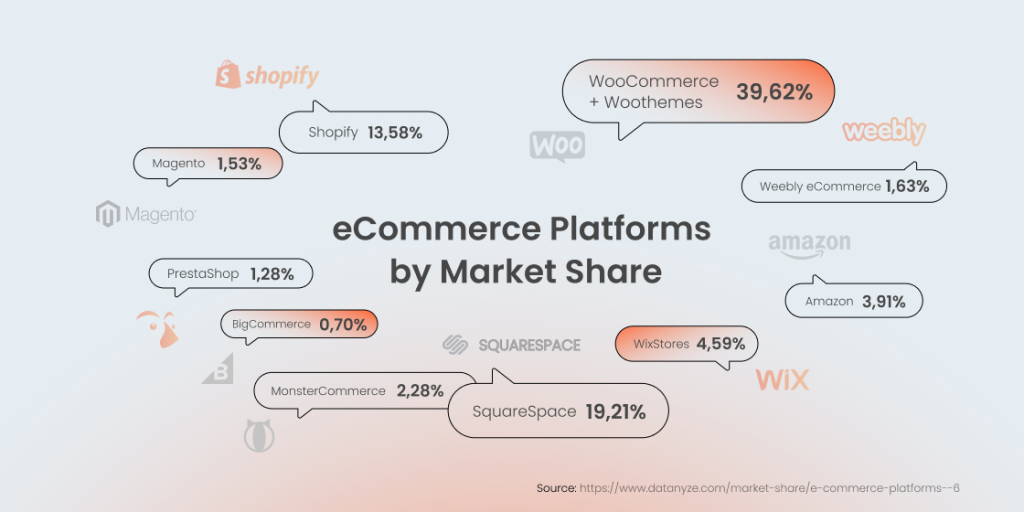
With up to 24 million online stores in the US alone, it’s safe to assume that ecommerce business owners are taking different paths when developing their digital storefront. Some choose proprietary ecommerce website development, while others prefer to hire developers to adapt one of the existing ecommerce platforms to their needs. If you’re considering the latter option, here are the leading ecommerce platforms by market share.
- WooCommerce + WooThemes — 39.62%
- SquareSpace — 19.21%
- Shopify — 13.58%
- WixStores — 4.59%
- Amazon — 3.91%
- MonsterCommerce — 2.28%
- Weebly ecommerce — 1.63%
- Magento — 1.53%
- PrestaShop — 1.28%
- BigCommerce — 0.70%
The evolution of the ecommerce market creates a stark contrast (in both longevity and revenue) between businesses that adapt quickly and businesses that don’t. A successful ecommerce business in 2022 must diversify their supply chain and engage their customers across multiple marketing channels (including social media). New businesses should be mindful of competition in their niche and choose their ecommerce platform based on its flexibility and long-term ability to scale.
The Global State of Ecommerce & the Biggest Players
Even if the focus of your ecommerce business is North America, it’s always a good idea to know what is going on globally in this ever-changing industry. Ecommerce is rapidly developing around the world, and this is where things stand at the moment.
Marketplaces Dominate the Industry
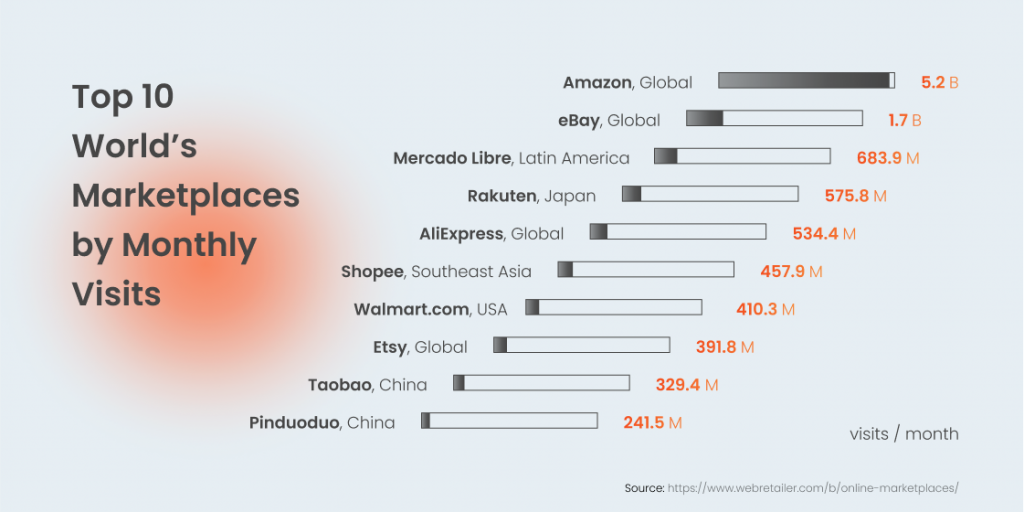
The presence of marketplaces on the international ecommerce market is strong and it’s only getting stronger every year. In 2021, 48% of all online shoppers around the world would start their search on one of the popular marketplaces. There are now marketplaces in every part of the world, and a few standout companies that operate globally. Above you’ll find the top 10 marketplaces of 2021 by monthly visits.
13% of the Global Ecommerce Market Belongs to Amazon
Amazon is one of the top players on the international ecommerce scene, and the past two years have only strengthened its positions. It currently has a 13% market share globally, and in the US, Amazon’s presence is even more powerful, with 52% of the national ecommerce activity happening on this platform.
Asian Marketplaces are on the Rise
Although Amazon remains a force to be reckoned with, especially in the Western part of the world, there are areas on the global map where Amazon isn’t even close to the top of the list. In Asia and many European countries, those positions are firmly occupied by Asian marketplaces and Alibaba in particular.
Alibaba is especially big in Eastern Europe with a 2.9% market share in the previous year. And during Singles Day, the biggest shopping event in Asia, Alibaba and JD.com together racked up $139 billion in sales.
Asia Leads in Sales Growth in 2021
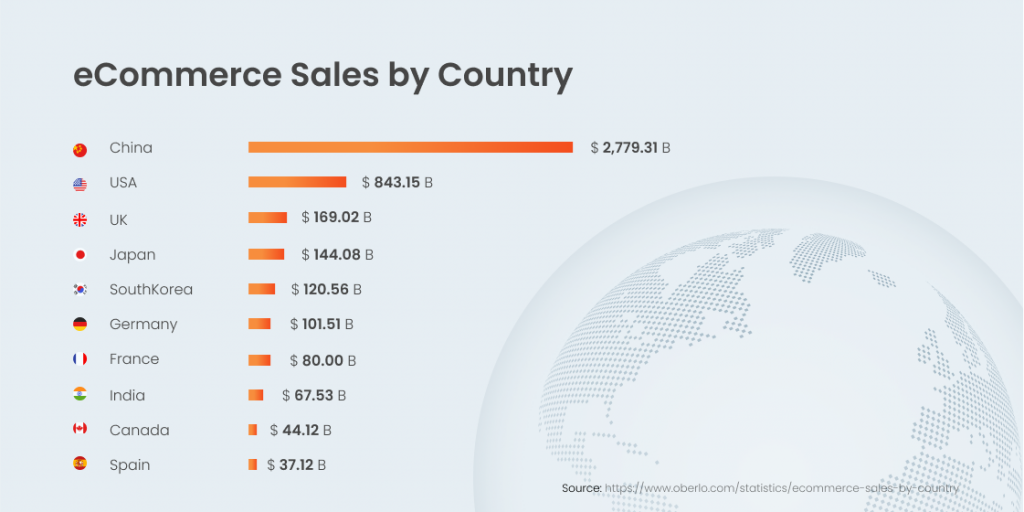
Since early 2020, ecommerce sales have grown everywhere on the planet, but some regions displayed an even more impressive increase.
Namely, China became the undisputed leader of ecommerce sales in 2021, having reached almost 3,3 times more in sales than its closest competitor, the United States. Japan, South Korea, and India are three other Asian countries out of the top 10 international markets in ecommerce sales.
Localization Matters to Foreign Buyers
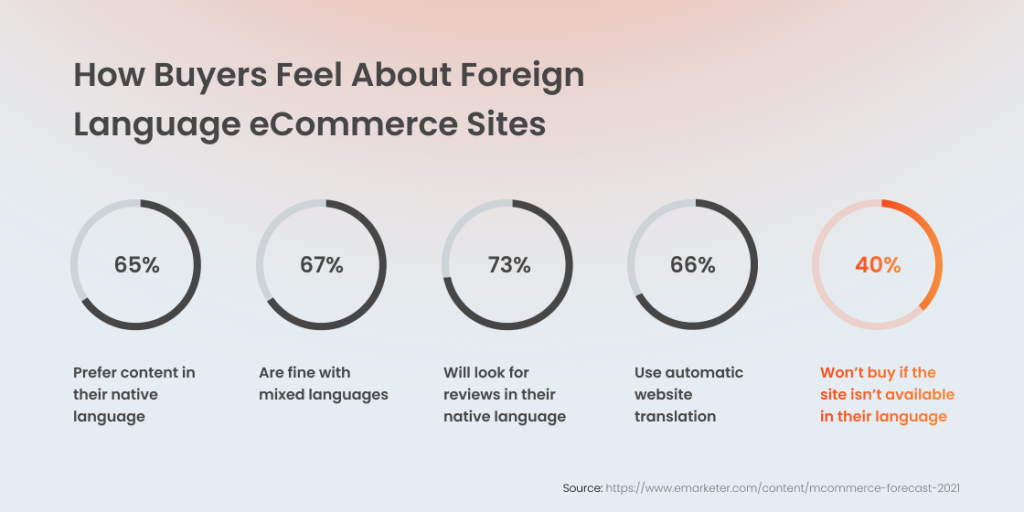
The nature of ecommerce helps break down the barriers for international buyers, but it’s only possible when the service is available in the buyer’s native language. According to a survey, 1 in 5 buyers considers the lack of localization to be a big barrier that could stop them from making a purchase.
Moreover, as buyers are relying on product reviews in their decision-making process, they are also determined to find reviews in their own language. 66% of international buyers will use an automatic translation option if it’s available, but machine translation can often lead to misunderstanding. So if you plan to venture into the international market, consider using professional localization services.
Ecommerce is booming not just in the US, but also globally. And while there are some big names on the international market already, with a strong strategy and an approach tailored to the specific needs of the audience, there can be room for new players.
Mobile Ecommerce Trends
With almost 6.4 billion smartphone users in the world in 2021 and the smartphone penetration rate ranging from 45% to 95% in different parts of the planet, the mcommerce market looks very promising. Here are the key mcommerce trends right now.
The Current State of Mcommerce
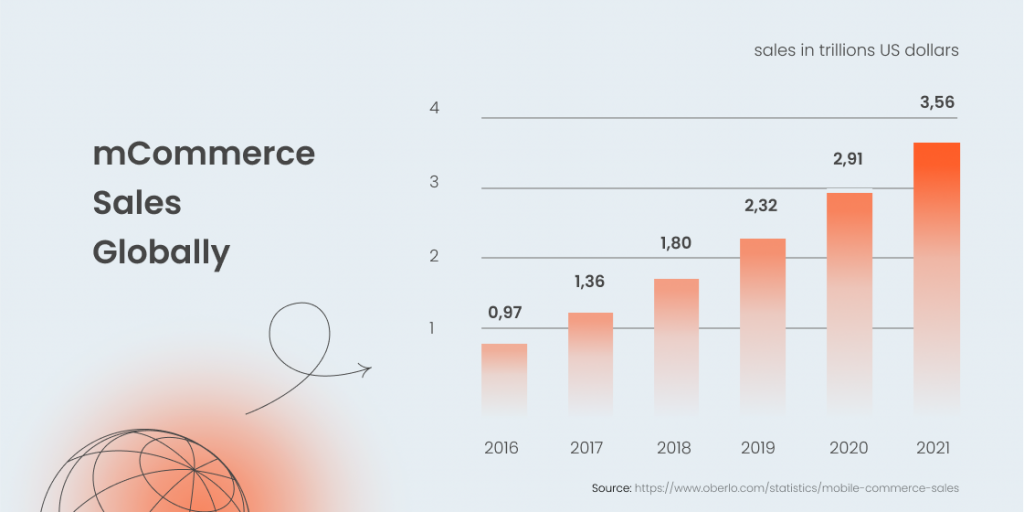
Mcommerce sales continue growing steadily year after year. Sales in the mobile ecommerce market have been increasing rapidly for the past five years, so the growth isn’t associated as much with the pandemic as with the record-high smartphone penetration rate around the world.
In 2021, mcommerce sales globally amounted to $3.56 trillion, and that’s a 22.3% increase compared to 2020, when mCommerce generated $2.91 trillion in sales.
How Many People Shop from their Smartphones
By an estimate, there are 2 billion people in the world who have made at least one purchase online. And mobile sales are not that far behind, with 3 out of 4 ecommerce users globally shopping from their smartphones.
Moreover, many mobile buyers use an omnichannel shopping tactic, where they browse an ecommerce website from their desktop computer and eventually make the purchase on a mobile device — 58% of all multi-device purchases are closed on mobile.
Mcommerce Continues its Expansion

In 2020, mcommerce was responsible for 5.5% of total retail sales in the United States. In 2021, it increased to 5.9%. It is estimated that by 2025, 10.4% of all retail sales in the US will be done on mobile devices.
With the continued spread of new mcommerce technologies, such as AR and 5G, as well as the popularity of quick payment methods such as Apple Pay and Google Pay, mcommerce is going to become even more powerful in the coming years.
China is the Biggest Mcommerce Market
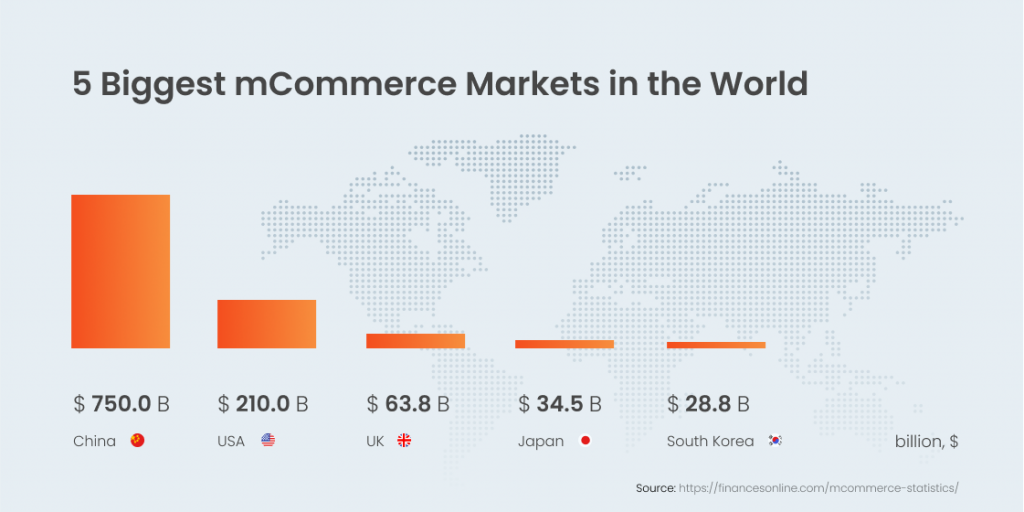
We’ve already talked about the strong positions of ecommerce in the Asian market. Unsurprisingly, Asia in general and China in particular are also leading in the mcommerce segment. 3 out of 5 mcommerce markets in the world are in Asia.
China is leading the pack with $750 billion in mcommerce sales, Japan is fourth with $34.5 billion, and South Korea takes the fifth spot with a $28.8 billion mcommerce market.
Asia is also in the lead when it comes to the percentage of mobile transactions. With 79.1% of transactions happening on mobile in Indonesia, 74.2% in Thailand, and 69.6% in the Philippines, Asia emerges as the most up-and-coming mcommerce market globally.
Mobile Banking Grows Steadily
The expansion of mobile commerce is impossible without the change in the banking habits of the world’s population. Specifically, with more than 1 billion users around the globe, mobile banking is now one of the fastest-growing mcommerce-related technologies.
For some, mobile banking simply means access to quick transactions and better banking account control. For others, especially in Asia and Africa, mobile banking acts as the only form of financial inclusion when there are no other options.
The mcommerce market is developing at the same rate as traditional ecommerce, or even faster in certain parts of the world. The number of smartphone owners and mcommerce users increases every year. But succeeding in the competitive mobile commerce market is virtually impossible without the use of cutting-edge technologies and catering to the specific needs of the growing mcommerce audience.
B2B Ecommerce Trends
The times when B2B deals were made strictly in person or over the phone are gone. Modern B2B companies have successfully expanded their presence to the online realm, and here are the most important insights from the world of B2B ecommerce.
B2B Marketplaces Improve their Positions
B2B companies are no longer exclusively selling their products and services through their own websites. B2B marketplaces have grown significantly over the past few years. This trend is developing in the same vein as traditional ecommerce marketplaces, as more and more B2B providers and customers are discovering the benefits of marketplaces.
Last year, it was reported that 26% of B2B customers complete between 50% and 74% of their purchases online, and 9% of customers make over 75% of their total B2B purchases from marketplaces.
B2B Companies Face Technological Challenges
B2B companies are adapting to the ecommerce market at a different pace. Some are developing proprietary solutions from scratch while others are trying to maintain and update their existing solutions. 57% of B2B companies are facing challenges connected to the integration and updates of their legacy systems.
On top of that, 44% reported struggling with finding the right solution partner, and that can be easily explained — there is a lot riding on high-quality ecommerce software development. So the decision to hire ecommerce developers is one of the smartest ones a B2B company looking to venture into the ecommerce market can make.
Buyers Prefer Self-Serve Operations
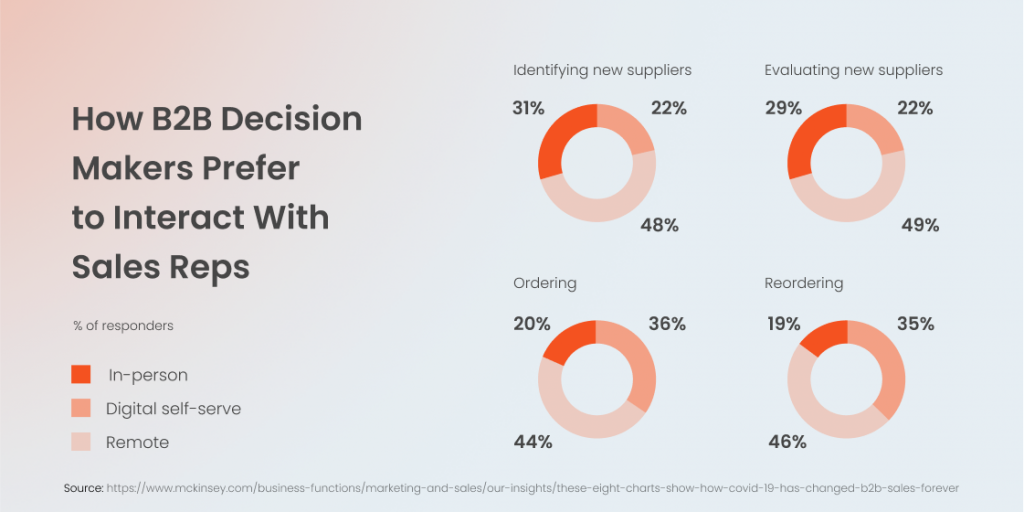
Face-to-face B2B sales used to be the only way to conduct business in this competitive market. These days, however, face-to-face B2B operations are giving way to remote and self-serve purchases. At different stages of B2B purchases, from 22% to 35% of B2B consumers prefer digital self-serve, and from 44% to 48% of them want to do things remotely.
This trend, at least in part, stems from the fact that 73% of decision-makers in the B2B segment are now millennials, who are more open to self-serve and remote operations compared to older generations.
Content is Key for Ecommerce Sales
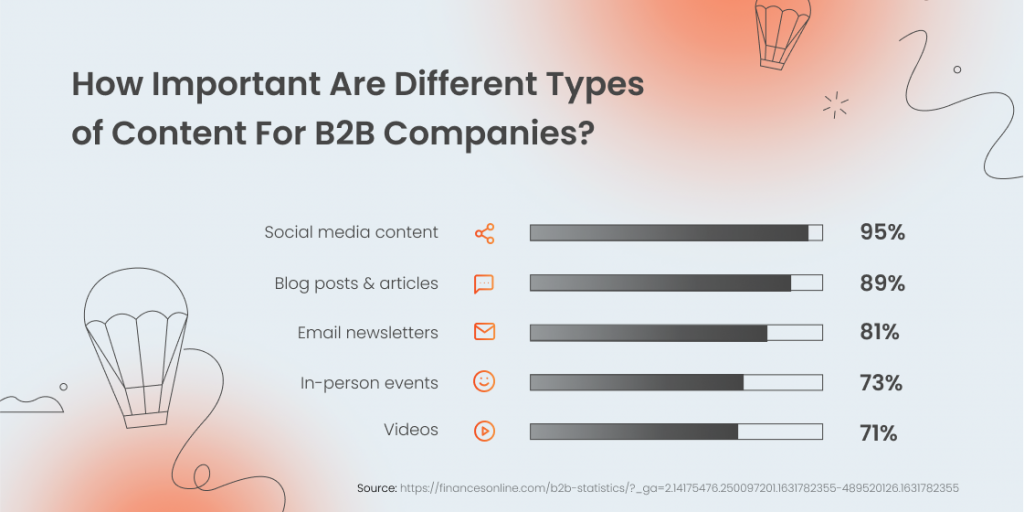
B2B ecommerce trends may come and go, but content remains a key part of a successful marketing strategy for a B2B company. Quality content can often be the one thing that propels a B2B company to success and helps it stand out from the competition.
And different types of content can work perfectly for different industries and marketing goals. Specifically, the most popular types of content used by B2B enterprises include:
- Social media content — 95%
- Blog posts or short articles — 89%
- Email newsletters — 81%
- Videos — 71%
Email marketing remains a particularly vital part of a B2B marketing strategy, with 79% of respondents saying that email newsletters are the most effective tool for generating demand. And despite all the growth of digital marketing, live events are not going anywhere: 73% of B2B companies regularly organize in-person events to attract new customers.
The B2B ecommerce market is developing as rapidly as traditional ecommerce, but has its own trajectory and faces unique challenges, including legacy system maintenance and update. A strong marketing campaign, as well as the right choice of ecommerce software development partners, can make a significant difference in a B2B company’s position in the market.
Ecommerce Consumer Behavior Trends
The ecommerce industry is evolving, and so are the needs and expectations of ecommerce users. Buyers are now more selective about the ecommerce business they support and their shopping preferences in general. These are the most noticeable consumer behavior trends of the year.
There is a Generational Gap in Ecommerce
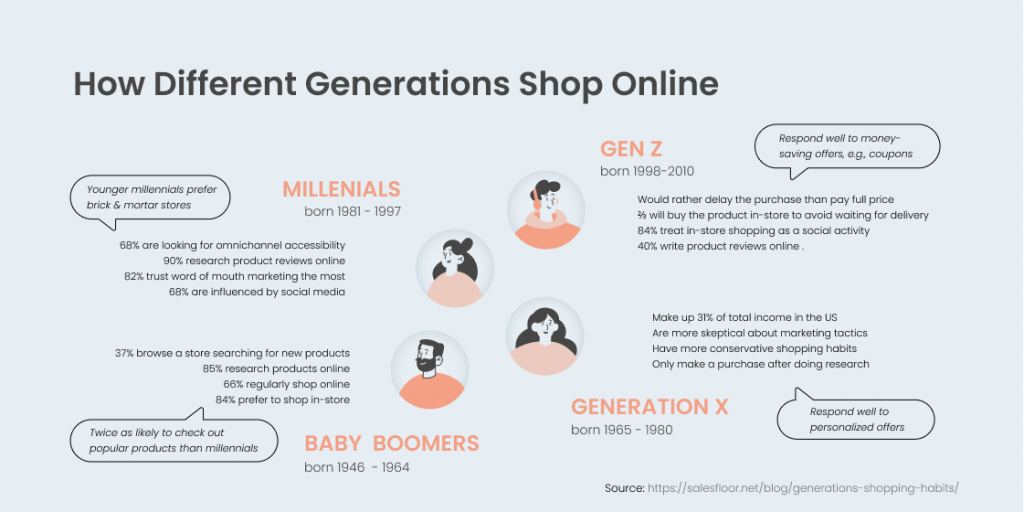
Different generations are not adopting online shopping at the same rate. There is a significant difference in the way baby boomers, Gen X, millennials, and Gen Z shop online. Here are the key ecommerce trends for every generation:
- Baby boomers value convenience above everything else. Shopping is a necessity rather than a relaxing activity for them, and only 37% of boomers reported that they are open to browsing the store for new products. When it comes to online, 85% of them will research products in their web browsers, but only 66% report regularly buying online.
- Gen X is often ignored by marketing campaigns, which is definitely an oversight, as Gen X is responsible for 31% of the total income in the US. When choosing a product or a platform to shop, Gen Xers are looking for two things: reputation, which they research through online reviews, and offers personalized to their needs.
- Millennials are the generation that can be the perfect target audience for omnichannel marketing tactics. And younger millennials are more likely to buy from a brick and mortar store than older millennials. 82% of millennials report trusting word-of-mouth marketing the most, and 68% admit to being heavily influenced in their shopping decisions by the content they see on social media.
- Gen Zers are a digital-native generation, and that heavily influences their attitude to online shopping. They will always research products and compare prices online before making a big purchase. At the same time, Gen Z treats shopping as a social activity, with 84% of them preferring shopping in brick and mortar stores with friends.
Buying from Abroad is Very Popular in the US
With Amazon and other American marketplaces and ecommerce stores being such a big presence in the retail industry in the US, it may seem like American buyers can get everything they need at home.
However, statistics indicate a different situation in ecommerce. Over 50% of buyers in the US buy from abroad, and around the world, that number is close to 70%. Moreover, it is predicted that by the end of 2022, ¼ of ecommerce shopping will be done internationally. And for 80% of ecommerce retailers, the experience of selling to foreign buyers has been nothing but profitable.
Eco-Friendly Shopping is a Prominent Trend
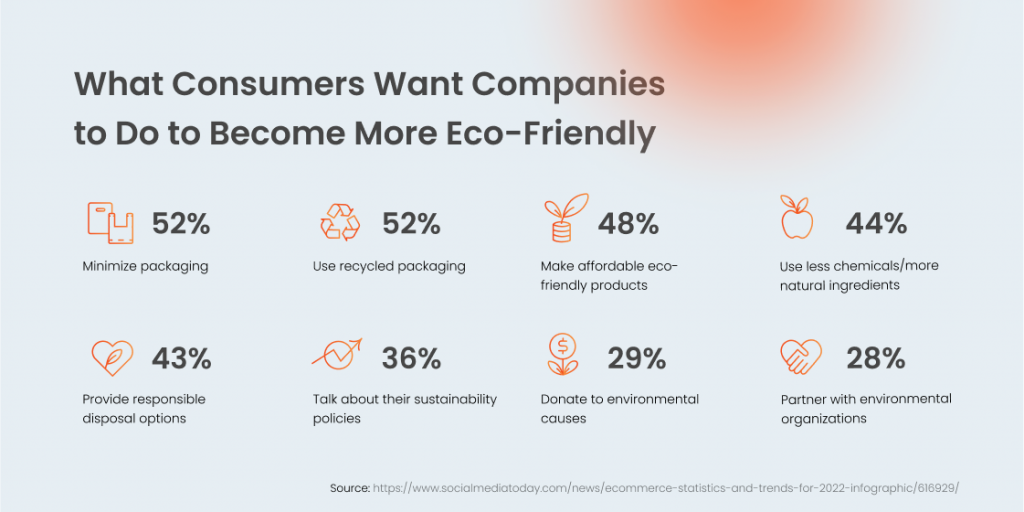
With people all over the world being more and more aware of the environmental challenges the planet is facing, the shopping habits of the world’s population have also shifted towards eco-friendliness. Over 52% of consumers in the UK reported getting more eco-aware in the past year.
And their buying preferences have changed accordingly: 52% of consumers expect brands to create products with less packaging, 70% want brands to do more to help environmental causes, and 48% want eco-friendly products to become more affordable.
There’s Been a Drop in Holiday Shopping Compared to 2020
In 2021, both Black Friday and Cyber Monday sales have dropped compared to the previous year, which was for the first time in recent history. Black Friday 2021 racked up $8.9 billion in sales, which is a noticeable drop from $9 billion generated by Black Friday sales in 2020.
Cyber Monday saw a similar decline: $10.7 in 2021 vs. $10.8 in 2020. The drop in both shopping events isn’t dramatic, but it may be a sign that ecommerce users are approaching shopping more consciously and are not as likely to be swayed by promotions.
Men Spend More on Ecommerce than Women
In addition to the generational gap in the shopping preferences of ecommerce users, there is also a visible gender gap. According to recent data, men and women shop online at a similar rate, but men tend to spend more per transaction: $220 vs. $151 spent by a woman on average.
This can be explained by the fact that men and women typically go for different ecommerce categories when shopping online: gadgets and watches are more popular among men, whereas women are more likely to shop for makeup, skincare, and fashion items.
2020 and 2021 Brought a High Return Rate
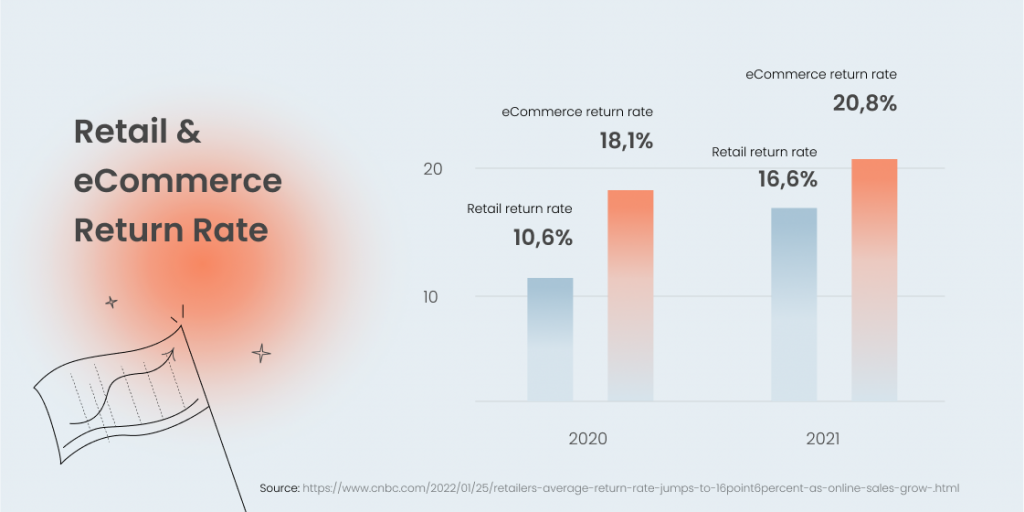
The significant increase in ecommerce sales has had a noticeable side effect: the increase in return rates, both in traditional retail and ecommerce. In 2020, retail buyers returned 10.6% of the goods they had previously purchased. In 2021, the return rate reached 16.6%. That can amount to $761 billion in merchandise returning to the stores and warehouses.
The number is even higher for ecommerce stores — in 2021, 20.8% of the goods purchased online were eventually returned.
Some of the ways ecommerce companies are trying to alleviate the damage from high return rates is opening pop-up stores that allow customers to try the product before buying, creating virtual fitting rooms, or taking a leaf out of Amazon’s book and giving out refunds but telling the buyers to keep the item. This can be the preferred option in case the cost of shipping and storing the product is higher than the cost of the item itself.
Grocery Online Shopping has Grown Significantly
Grocery has never been the fastest growing ecommerce sector before 2020. Then Covid-19 with its multiple lockdowns happened. All forms of grocery ecommerce shopping — including home delivery and click-and-collect services — have become the norm for buyers in the US and many other world regions.
According to a report, 43% of millennials buy at least half of their groceries online. Grocery ecommerce is expected to finish 2022 with a 21% increase in sales.
Buy Now Pay Later is Gaining Popularity
Buy Now Pay Later payment methods, which have become the main alternative to credit cards in recent years, show no signs of slowing down. During last year’s Cyber Week, BNPL has seen a 23% increase globally.
And 7% of ecommerce shoppers had plans to use Buy Now Pay Later for their holiday shopping in 2021. Currently, BNPL appears to be especially popular among the younger ecommerce audience, with Gen Zers and millennials adopting the new technology at a quick pace.
Ecommerce buyers have different shopping habits that depend on their age, gender, and other factors. Buyers are now also more likely to research products before making the purchase and use different shopping channels and payment methods. As the ecommerce landscape is changing rapidly, consumer behavior has gotten harder to predict. ecommerce business owners need to analyze the trends and pay attention to the forecasts, as up-to-date knowledge can help them stay on top of the customer expectations.
Data Privacy and Security Trends
2021 has brought major changes to online privacy and how we view it. Some of these changes can potentially have a big impact on ecommerce and marketing, and some are already changing the advertising market. Here is what has happened in this regard so far.
Consumers are More Aware of Data Usage by Ecommerce Services
Ecommerce buyers are no longer blindly trusting brands with their personal data. They want to know what brands are doing with it and are demanding a more responsible and transparent approach.
Specifically, 61% of respondents interviewed by Shopify say they will only share their private information with a brand if required, 57% report growing concerns about how their data is used, and 40% have stopped buying from a brand when there were concerns about data usage by that brand.
Apple Introduces Data Tracking Opt-Out
One of the biggest changes to data privacy in 2021 came from Apple. The company introduced a data tracking opt-out feature in iOS 14.5, and things have not been the same since. Brands have gotten far fewer opportunities to create targeted offers and attract new customers based on their behavior.
The change has been especially noticeable for Facebook, which heavily uses data collected from users to target their ads. In turn, brands that frequently advertised through Facebook ended up paying a higher price for ads that did not generate the anticipated revenue.
Third-Party Cookie Block
Another privacy-related update comes from Google, who in February of 2020 announced that it was going to phase out third-party cookies in Chrome by 2022. Since then, Google moved the phase-out date to the second half of 2023.
Google admits that Chrome’s competitors may continue using third-party cookies to track user activity, but with over 65% of users worldwide using Chrome, brands and advertisers will still need to look for new ways to reach their target audience.
The growing awareness of data privacy issues among consumers creates additional challenges for ecommerce businesses and major advertising platforms. Instead of relying on tried and tested marketing tactics, such as tracking user behavior on the internet, companies will have to get more creative when targeting their offers.
Up-and-Coming Ecommerce Technologies
Ecommerce is one of the industries that develop proactively instead of simply reacting to the changes. Every year brings plenty of innovations in this field, and 2022 is also offering new ways to stand out in the competitive ecommerce market. Here are some of the new online shopping technologies to consider.
Conversational Online Shopping
As more and more consumers are demanding shopping convenience and personalization, conversational online shopping can become the solution ecommerce businesses are looking for.
This includes chatbots, both the likes of Facebook Messenger and live chat widgets on ecommerce platforms, and voice shopping apps that work similarly to Alexa and Siri and help brands reach out to customers more effectively. Voice shopping is an especially promising technology, with voice shopping sales expected to reach $19.4 billion by 2023.
Google Local Inventory Ads
With Covid-related restrictions being gradually lifted, buyers are returning to brick and mortar stores. However, they are now so used to the convenience of online shopping that they are not ready to simply give it up.
This is why the Local Inventory ads rolled out by Google were met with excitement by ecommerce stores. These ads are available in the US, the UK, Australia, New Zealand, Brazil, and Western Europe. They allow the stores to advertise their stock, driving more customers to the physical stores and increasing brand awareness.
Personalized Shopping Experience
For an ecommerce business to get ahead of the competition, it needs to have a unique selling proposition. And when an ecommerce store is selling the same product as dozens of other stores, standing out can be challenging. A personalized shopping experience can be the one thing that propels you to buyer recognition.
According to a study, 80% of buyers have come to expect a personalized shopping experience. And it’s not just about targeted offers, which have definitely existed before, or mass promotions. It’s about the entire buyer’s experience. It’s no longer enough to address the customer by their name in an email. An ecommerce business needs to use multiple types of data to address the needs of the buyers and increase their loyalty.
Headless Ecommerce
Traditionally, ecommerce solutions are developed as a whole: the front end and the back end of the application are deeply intertwined, which sometimes post challenges when working with unusual platforms or when quick updates are required. This is why headless ecommerce architecture is now quickly adopted by various companies.
Under headless ecommerce architecture, the back end of the application is developed independently from the front end. As a result, the content of the application can be displayed not only on a small range of devices, such as desktop computers and smartphones, but also on any type of screen there is. This is achieved through the use of API. Headless ecommerce is exactly what companies need in the IoT era.
Augmented Reality in Online Shopping
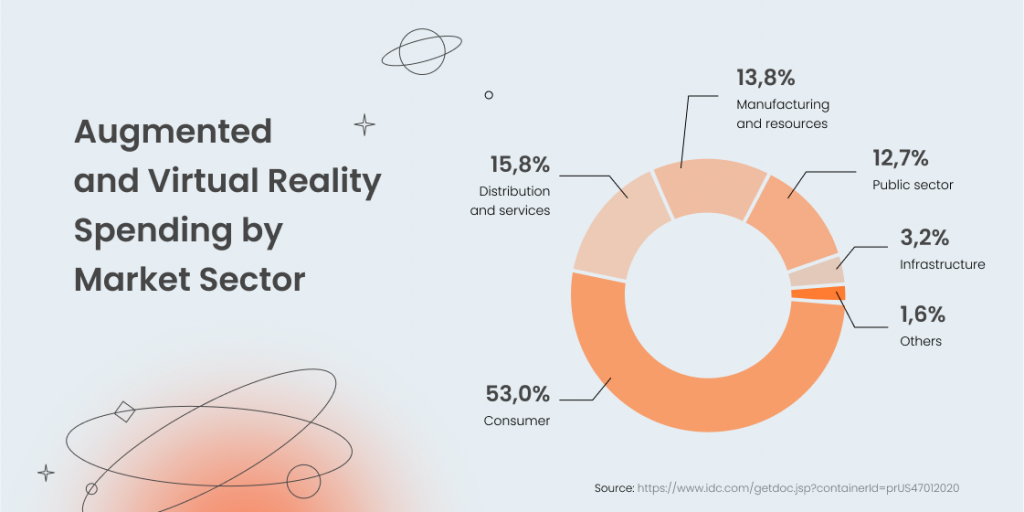
Even with all the technological advancements, there is still a gap in the shopping experience when buying offline and online. Augmented reality in ecommerce is designed to bridge that gap. When used correctly, AR can help an ecommerce brand achieve higher customer loyalty, increase the conversion rate, and reduce return rates. Some of the examples of augmented reality being used in ecommerce include:
- Virtual fitting rooms
- Seeing how furniture and decor items can look at home
- Trying different wall paint colors
- Testing different hair colors and makeup
- Creating interactive user manuals
Livestream Shopping
Livestream shopping, otherwise known simply as live shopping, is the type of ecommerce where products advertised on video are being sold in real time. The most common example of livestream shopping is when social media influencers review their favorite products online and there is a link or button where you can shop those products.
Another example is live runway shows where you can purchase the clothes demonstrated by the models. Livestream shopping makes brands one step closer to their customers and helps them reach out to the specific kind of audience that reacts well to influencer marketing.
Dynamic Pricing
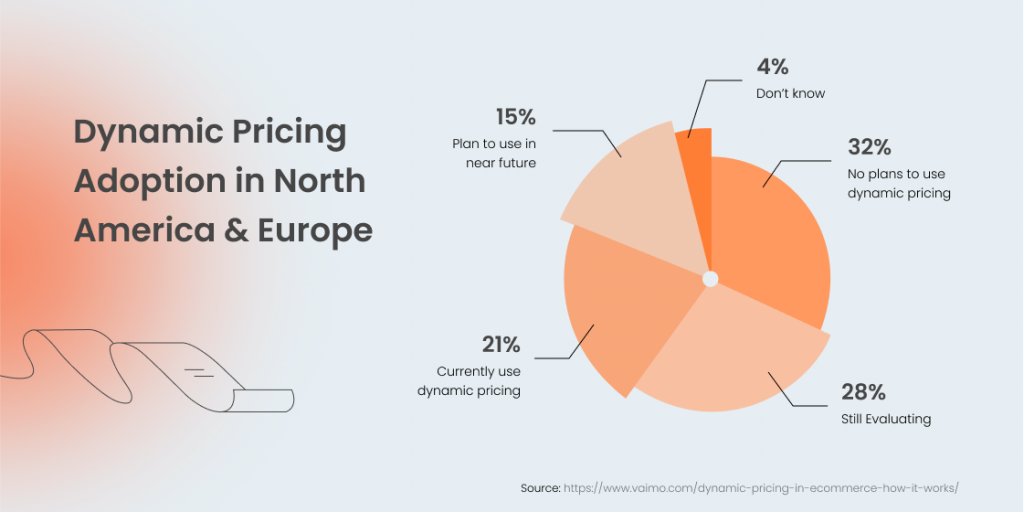
Dynamic pricing is, of course, far from a brand new concept. Adjusting the prices to the changes in supply and demand has been around for centuries. However, the access to brand new technologies helps ecommerce companies further use dynamic pricing to their advantage. These days, an ecommerce business can change prices on a minute-to-minute basis using a variety of factors:
- Supply and demand
- Inventory level
- Market trends
- Consumer expectations
- Consumer behavior, e.g. on the website
- Immediate competition
Then, based on the data obtained through different channels, an online store can use price management automation tools to select the most appropriate prices for each item. The biggest benefit of using dynamic pricing is the ability to maximize the profit on every item sold.
Modern technology unlocks endless possibilities for ecommerce businesses. From creating a price strategy and making the existing ecommerce solution more flexible by using headless ecommerce to reaching out to the target audience more effectively with local inventory ads and livestream shopping tools, an ecommerce platform should constantly work on staying at the forefront of technology.
Final Thoughts
The past two years have been transformative for the ecommerce industry. It has gotten an unprecedented boost because of Covid-19 and continues growing on its own. But in order to keep the momentum going, ecommerce businesses need to focus on creating the change, not reacting to it, and quickly adopting the trends to retain the loyalty of existing customers and appeal to new ones.